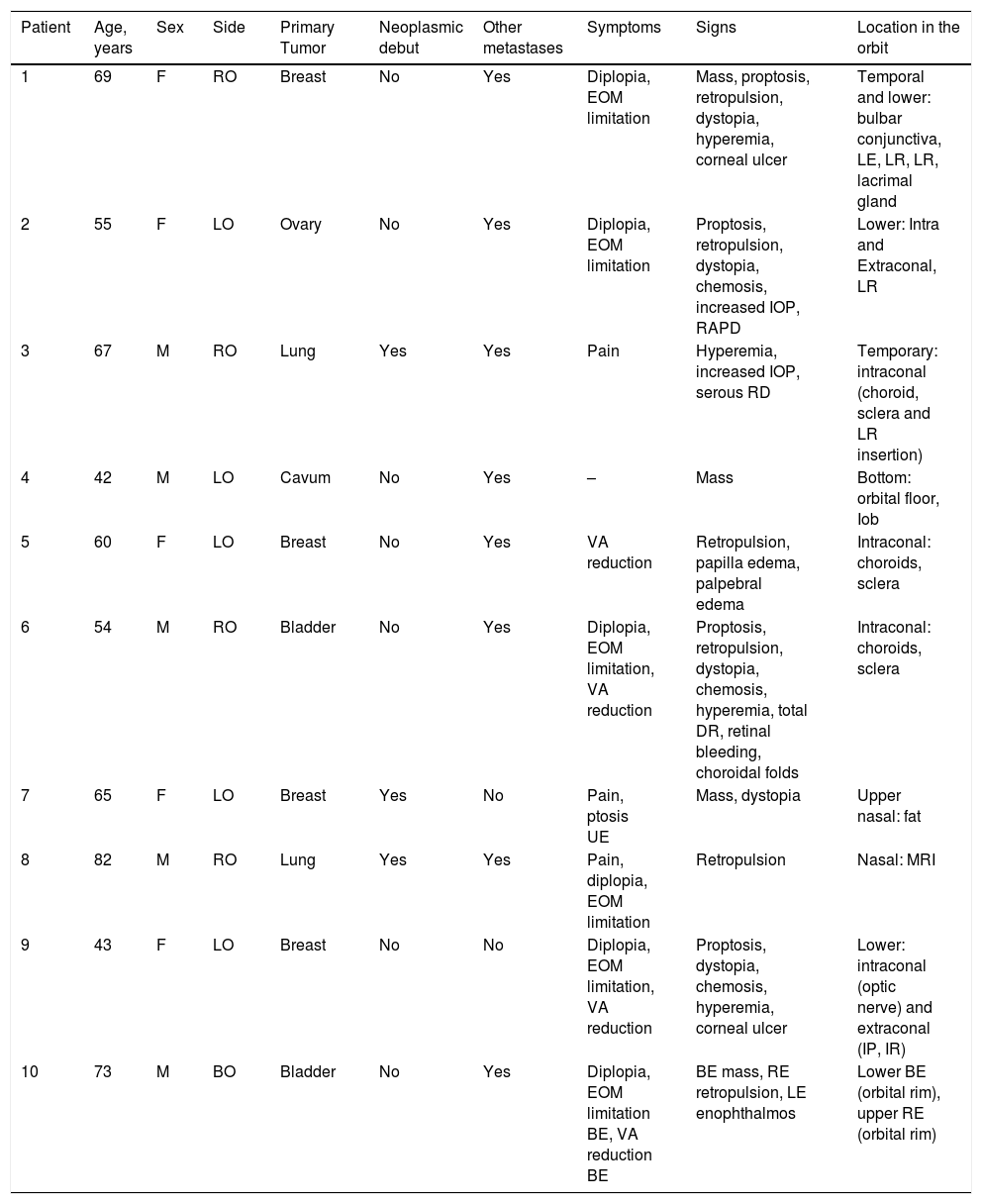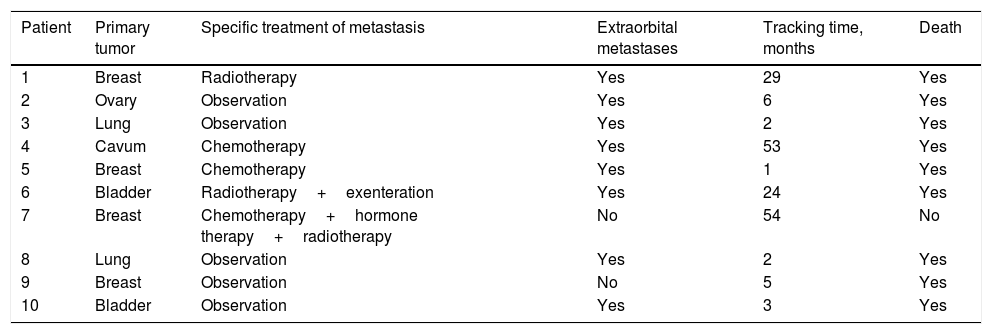Orbital metastases are an uncommon condition. They may be the clinical presentation of a previously unknown malignancy. Depending on the series, the rate of orbital metastasis as a first manifestation of a malignant tumour is 20%–42%. The clinical presentation and survival is presented in a series of 11 cases of orbital metastasis corresponding to 10 patients.
Material and methodsDescriptive retrospective study of a series of 10 adult patients diagnosed with orbital metastasis from solid tumours during a 9-year period. Metastasis involving the orbit was included, and lymphomas and contiguity invasions from adjacent structures were excluded. A note was made on whether the clinical picture was the first sign of tumour onset. Signs and symptoms at clinical debut were registered, as were primary tumour location, distance seeding, orbital structures involved, and survival time since the diagnosis was established.
ResultsOne-half (50%) of the patients were women. Mean age at diagnosis was 60.9 years (range 42–82). In nine cases (90%), the metastasis was unilateral, while in the remaining one the involvement was bilateral. The most frequent primary tumour location was the breast (36% of the cases); followed by the bladder (27%), lung (18%), and ovary and cavum (9%). Seventy percent of the patients had a previously diagnosed neoplasm; in 3 cases the metastasis was the first malignancy manifestation. Most frequent symptoms were diplopia (60%), visual impairment (40%), and pain (30%). The most common signs were resistance to ocular retropulsion (60%), presence of a mass on orbital palpation, and ocular dystopia (50%), and bulbar hyperaemia and proptosis (40%). The most employed management modality was clinical observation (5 patients). In 3 patients radiotherapy was administered, combining chemotherapy plus hormonal therapy in one case, and orbital exenteration in another one. In 2 cases, chemotherapy was administered as an isolated regime. Median survival time was 4.8 months since the diagnosis. There was a statistically significant difference between the survival time in the observation group (median 2.5 months) and in the active treatment group (median 29.2 months), p=.034.
ConclusionsIn the series presented, 27% of the cases established the clinical debut of the malignant neoplasm. The ophthalmologist plays an essential role when this condition is suspected, diagnosing it, and proposing its management together with the Oncology Service.
Las metástasis orbitarias son una entidad infrecuente. Pueden suponer la presentación de un tumor maligno desconocido previamente; según las series, el porcentaje de metástasis orbitarias como primera manifestación de una enfermedad maligna es de un 20–42%. Describimos la presentación clínica y la supervivencia en una serie de 11 casos de metástasis orbitarias correspondientes a 10 pacientes.
Material y métodosEstudio descriptivo retrospectivo de una serie de 10 pacientes adultos diagnosticados de metástasis orbitarias de tumores sólidos durante un period de 9 años. Se incluyeron metástasis que afectasen a la órbita, excluyendo linfomas e invasiones por contigüidad. Se especificó si la clínica fue la primera manifestación del tumor. Se registraron los síntomas y signos en el debut clínico, localización del tumor primario, si existía extensión a distancia, estructuras orbitarias afectas y tiempo de supervivencia desde el diagnóstico.
ResultadosLa mitad de los pacientes fueron mujeres. La edad media al diagnóstico fue de 60,9 años (rango 42–82). En nueve casos (90%), la metástasis fue unilateral, mientras que en el restante la afectación fue bilateral. La localización más frecuente del tumor primario fue la mama (36% de los casos); seguida por la vejiga (27%), pulmón (18%), ovario y cavum (9%). El 70% de los pacientes tenían enfermedad neoplásica diagnosticada previamente; en 3 casos la metástasis fue la primera manifestación del tumor. Los síntomas más frecuentes fueron diplopia (60%), disminución visual (40%) y dolor (30%). Los signos más frecuente fueron la Resistencia a la retropulsión ocular (60%), la presencia de una masa a la palpación orbitaria y la distopia ocular (50%), la hiperemia bulbar y la proptosis (40%). La modalidad de manejo más empleada en la serie fue la observación (5 pacientes); en 3 pacientes se recurrió a la radioterapia, asociando quimioterapia y tratamiento hormonal en un caso y exenteración orbitaria en otro. En 2 casos se propuso tratamiento quimioterápico como régimen aislado. La supervivencia mediana fue de 4,8 meses desde el momento del diagnóstico. Existieron diferencias estadísticamente significativas entre la supervivencia del grupo de pacientes sometidos a observación (mediana 2,5 meses) y la del grupo sometido a tratamiento activo (mediana 29,2 meses), p=0,034.
ConclusionesEn nuestra serie, el 27% de los casos supusieron el debut de la neoplasia maligna. El oftalmólogo juega un papel esencial a la hora de sospechar esta entidad, diagnosticarla y plantear el tratamiento de acuerdo con el Servicio de Oncología.











